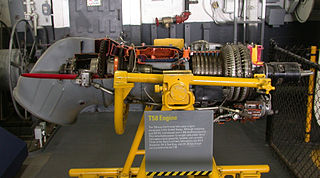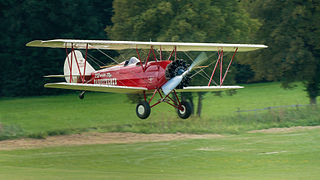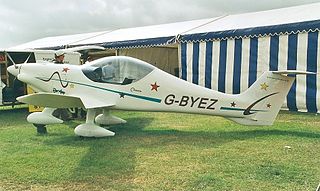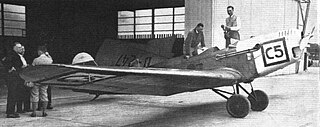Related Research Articles

The Bristol Mercury is a British nine-cylinder, air-cooled, single-row, piston radial engine. Designed by Roy Fedden of the Bristol Aeroplane Company it was used to power both civil and military aircraft of the 1930s and 1940s. Developed from the earlier Jupiter engine, later variants could produce 800 horsepower (600 kW) from its capacity of 1,500 cubic inches by use of a geared supercharger.

Wright Aeronautical (1919–1929) was an American aircraft manufacturer headquartered in Paterson, New Jersey. It was the successor corporation to Wright-Martin. It built aircraft and was a supplier of aircraft engines to other builders in the golden age of aviation. Wright engines were used by Amelia Earhart and Charles Lindbergh. In 1929, the company merged with Curtiss Aeroplane and Motor Corporation to form Curtiss-Wright.

The Junkers F 13 was the world's first all-metal transport aircraft, developed in Germany at the end of World War I. It was an advanced cantilever-wing monoplane, with enclosed accommodation for four passengers. 322 planes of the type were manufactured, an exceptionally large number for a commercial airliner of the era, and were operated all over the globe. It was in production for thirteen years and in commercial service for more than thirty.

Lycoming Engines is a major American manufacturer of aircraft engines. With a factory in Williamsport, Pennsylvania, Lycoming produces a line of horizontally opposed, air-cooled, four, six and eight-cylinder engines including the only FAA-certified aerobatic and helicopter piston engines on the market.

The Monosoupape, was a rotary engine design first introduced in 1913 by Gnome Engine Company. It used a clever arrangement of internal transfer ports and a single pushrod-operated exhaust valve to replace the many moving parts found on more conventional rotary engines, and made the Monosoupape engines some of the most reliable of the era. British aircraft designer Thomas Sopwith described the Monosoupape as "one of the greatest single advances in aviation".
The Adcox Aviation Trade School was established in Portland, Oregon in the 1910s. Aircraft created there as student projects starting in the late 1920s include the Adcox 1-A, Adcox Special, Adcox Student Prince, and Adcox Cloud Buster.

The Adcox Student Prince was a two-seat open-cockpit biplane designed by Basil Smith and built by the students of the US Adcox Aviation Trade School in 1929. It was based on the one-off Adcox Special, and the first example flew on 17 September.

The Daimler-Benz DB 601 was a German aircraft engine built during World War II. It was a liquid-cooled inverted V12, and powered the Messerschmitt Bf 109, Messerschmitt Bf 110, and many others. Approximately 19,000 601's were produced before it was replaced by the improved Daimler-Benz DB 605 in 1942.

The Avro 618 Ten or X was a passenger transport aircraft of the 1930s. It was a licensed version by Avro of the Fokker F.VIIB/3m.

The Rotax 912 is a horizontally-opposed four-cylinder, naturally-aspirated, four-stroke aircraft engine with a reduction gearbox. It features liquid-cooled cylinder heads and air-cooled cylinders. Originally equipped with carburetors, later versions are fuel injected. Dominating the market for small aircraft and kitplanes, Rotax produced its 50,000th 912-series engine in 2014. Originally available only for light sport aircraft, ultralight aircraft, autogyros and drones, the 912-series engine was approved for certified aircraft in 1995.

The Sonex, Waiex and Xenos are a family of lightweight, metal, low-wing, two seat homebuilt aircraft. Kits are produced and marketed by Sonex Aircraft, a small manufacturer based in Oshkosh, Wisconsin. By 2014, 500 customer built aircraft had been completed. The Sonex can also be built from plans.

The General Electric T58 is an American turboshaft engine developed for helicopter use. First run in 1955, it remained in production until 1984, by which time some 6,300 units had been built. On July 1, 1959, it became the first turbine engine to gain FAA certification for civil helicopter use. The engine was license-built and further developed by de Havilland in the UK as the Gnome, in the West Germany by Klöckner-Humboldt-Deutz, and also manufactured by Alfa Romeo and the IHI Corporation.

The Buhl-Verville CA-3 Airster, was a utility aircraft built in the United States in 1926, notable as the first aircraft to receive a type certificate in the US, issued by the Aeronautics Branch of the Department of Commerce on March 29, 1927. It was a conventional single-bay biplane with equal-span unstaggered wings and accommodation for the pilot and passengers in tandem open cockpits. Marketed for a variety of roles including crop-dusting, aerial photography, and freight carriage, only a handful were built, some with water-cooled engines as the CW-3, and others with air-cooled engines as the CA-3. One CA-3 placed second in the 1926 Ford National Reliability Air Tour.

The Kinner K-5 was a popular engine for light general and sport aircraft developed by Winfield B. 'Bert' Kinner. With the boom in civilian aviation after Charles Lindbergh's transatlantic flight the K-5 sold well. The K-5 was a rough running but reliable engine and the K-5 and its derivatives were produced in the thousands, powering many World War II trainer aircraft. The K-5 was followed by the B-5, R-5 and R-55. Military engines were designated R-370

The Travel Air 2000/3000/4000 (originally, the Model A, Model B and Model BH were open-cockpit biplane aircraft produced in the United States in the late 1920s by the Travel Air Manufacturing Company. During the period from 1924–1929, Travel Air produced more aircraft than any other American manufacturer, including over 1,000 biplanes. While an exact number is almost impossible to ascertain due to the number of conversions and rebuilds, some estimates for Travel Air as a whole range from 1,200 to nearly 2,000 aircraft.

The Dyn'Aéro MCR01 is a two-seat, low-wing, all-composite carbon fibre light aircraft that was originally manufactured by Dyn'Aéro and is now available in kit form and ready-to-fly through SE Aviation.

Bayraktar Akıncı is a high-altitude long-endurance (HALE) unmanned combat aerial vehicle (UCAV) being manufactured by the Turkish defence company Baykar. The first three units entered service with the Turkish Armed Forces on 29 August 2021.

The Klemm L 26, later Klemm Kl 26, was a low-wing trainer aircraft built by Klemm.
References
- ↑ "🔎 Liste des aéronefs (B) - Bensen". Techno-Science.net (in French). Retrieved 2023-05-04.
- ↑ "Adcox Cloud Buster / A-100 / Cloud Buster Junior / Bidwell Cloud Buster". all-aero.com. Retrieved 2023-05-04.
- ↑ "Adcox Cloud Buster / A-100 / Cloud Buster Junior / Bidwell Cloud Buster". all-aero.com. Retrieved 2023-05-04.
- ↑ "Civil Aircraft Register - United States". www.airhistory.org.uk. Retrieved 2023-05-04.
- ↑ "American airplanes: Ab - Ak". www.aerofiles.com. Retrieved 2023-05-04.